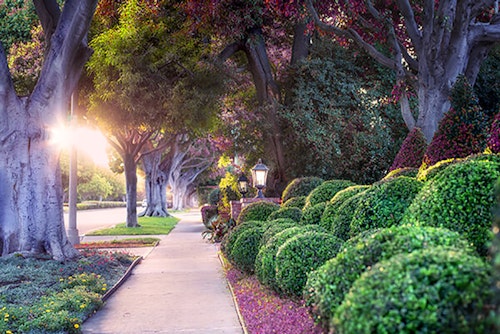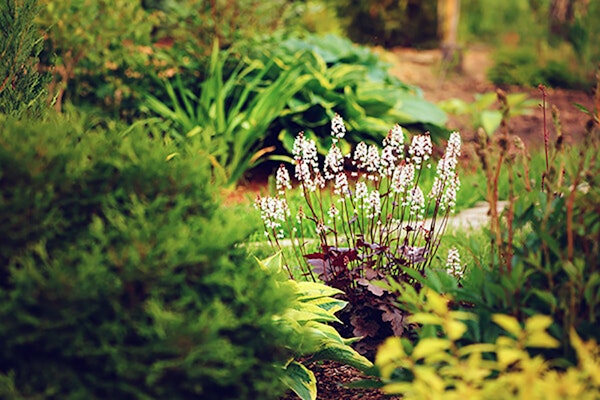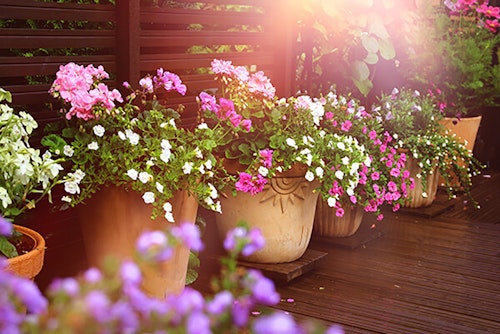 Back to the Be Inspired Blog
Back to the Be Inspired Blog

How Much Sun Will My Garden Get?
Sometimes it can feel like the luck of the draw when you’re trying to determine how much sun your garden will get. Some gardens are lit up with bright sun all day long, some are partially lit at different times throughout the day, and some barely get any sun at all. How can you tell if your garden will get sun? Ask yourself, “where does the sun hit my house?”
Why Cardinal Directions Affect How Much Sun Hits My House
Figuring out the direction from which the sun shines down on your house will help you to pick the best spots in the yard to plant different plants. The sun rises in the east and sets in the west, so that path it takes across the sky creates an ever-shifting light pattern in the yard. Shadows cast from trees and buildings will warp and change, so different areas in the yard will be lit at different times.
What Side of The House Gets the Most Sun?
South-facing walls, windows, and gardens will get the most sun! That’s because the earth is on a slight tilt, so the sun shines down on us from an angle. If you have a south-facing garden with barely any trees, you’ll probably have direct sun shining down all day. Thus, you'll want to plant your heat-tolerant plants that crave the most sun. Sun-loving flowers that bloom brightly in 6+ hours of sun per day, and vegetables like tomatoes, peppers, and eggplants do well in south-facing gardens.
North-facing gardens often get the least amount of sun—especially if they’re blocked by a tall fence or building. If you don’t have many trees, it still might get some sun during peak sunlight hours around noon. However, you’re likely going to be dealing with at least a few patches of shade throughout a north-facing yard. Use shade-tolerant plants like peonies, camellias, and hostas to add color to the dimmer, shady spots.
 East-facing gardens get lots of soft, gentle morning sun, but the scorching sun of the afternoon is often partially blocked. This is still a viable spot for a garden, because many plants are delicate and susceptible to heat scorch. A few hours of warm morning light each day will be enough to keep many plants happy. Leafy greens like spinach, cabbage, and arugula grow amazingly well in east-facing gardens, as do colorful flowers like impatiens and fuchsias.
East-facing gardens get lots of soft, gentle morning sun, but the scorching sun of the afternoon is often partially blocked. This is still a viable spot for a garden, because many plants are delicate and susceptible to heat scorch. A few hours of warm morning light each day will be enough to keep many plants happy. Leafy greens like spinach, cabbage, and arugula grow amazingly well in east-facing gardens, as do colorful flowers like impatiens and fuchsias.
West-facing gardens take the second place prize for the most amount of sun. The soft morning light is usually blocked, but the sun in the afternoon shines down brightly. A mix of full sun and partial sun perennials, annuals, and veggie plants will do just fine in a spot like this.
How to Determine Where the Sun Hits Your House
A compass app on your phone is one of the simplest ways to figure out which spots in your yard will be fully lit by the sun. Since the sun’s position changes, you can predict how much sun your chosen spot will receive based on the direction it’s facing. This confuses some folks, because your garden obviously doesn’t have a face. But really, it’s simple!
 Say you’ve got a spot in the yard where you’d like to plant a garden along the fence. That fence may block the sun for a portion of the day, so you want to stand with your back to the fence and read your compass to see what direction you’re facing. If you’re facing south, you don’t need to worry—that spot will get direct sun all day, provided there aren’t too many trees around. If it’s east-facing, it’ll get that morning light without the bright, afternoon light.
Say you’ve got a spot in the yard where you’d like to plant a garden along the fence. That fence may block the sun for a portion of the day, so you want to stand with your back to the fence and read your compass to see what direction you’re facing. If you’re facing south, you don’t need to worry—that spot will get direct sun all day, provided there aren’t too many trees around. If it’s east-facing, it’ll get that morning light without the bright, afternoon light.
If your yard has a lot of trees, you may have dappled shade. This is when the sun gets filtered through the leaves and tends to “sparkle” around your yard, creating pockets of sun and shade that are constantly changing. Shade-tolerant, or partial sun plants typically do well in dappled shade areas.
Do You Need a Special Device to Measure Hours of Sunlight Per Day?
Since our yards are often full of different trees, sheds, and other structures that cast shadows, sun mapping can become a bit more complicated. Some folks will splurge on sun meters or a complicated sun mapping garden app to measure their light levels, but we have a simpler solution! All you need is a camera, a pencil and paper, and a day off at home.
Set alarms on your phone for every hour during the day—from around 8am to 7pm. Each time the alarm goes off, go outside and take a photo of your yard. By the end of the day, you’ll have a series of photos that you can compare. This will help shed light on how the sunlight shifts in your yard, and how long certain areas are illuminated.
 Once you’ve got this information, you can map it all out on paper. Draw out a little map of your yard (it doesn’t need to look perfect) and try to section off the areas with different light patterns. Label them like so:
Once you’ve got this information, you can map it all out on paper. Draw out a little map of your yard (it doesn’t need to look perfect) and try to section off the areas with different light patterns. Label them like so:
- Full sun all day
- Bright afternoon sun
- Soft morning sun
- Dappled shade
- Full shade
Once you’ve got your yard mapped out, you can plan your garden accordingly! When the time comes to pick out your plants, visit SummerWinds to see everything available for 2021! We’ve got plenty of full sun plants for sale, as well as shade-tolerant and partial shade plants. No matter what direction the sun hits your house, you can have a thriving garden if you pick the right things to go in it. Feel free to ask one of our experts for help in picking the perfect plants—we’re eager to help!

